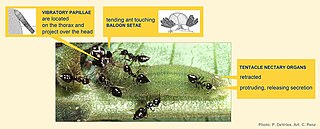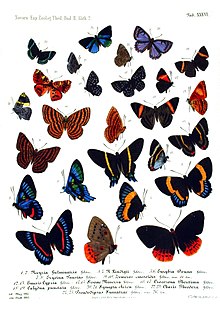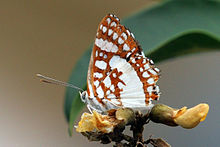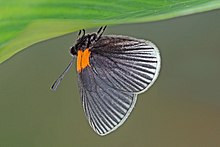
The Nymphalidae are the largest family of butterflies, with more than 6,000 species distributed throughout most of the world. Belonging to the superfamily Papilionoidea, they are usually medium-sized to large butterflies. Most species have a reduced pair of forelegs and many hold their colourful wings flat when resting. They are also called brush-footed butterflies or four-footed butterflies, because they are known to stand on only four legs while the other two are curled up; in some species, these forelegs have a brush-like set of hairs, which gives this family its other common name. Many species are brightly coloured and include popular species such as the emperors, monarch butterfly, admirals, tortoiseshells, and fritillaries. However, the under wings are, in contrast, often dull and in some species look remarkably like dead leaves, or are much paler, producing a cryptic effect that helps the butterflies blend into their surroundings.

The large blue is a species of butterfly in the family Lycaenidae. The species was first defined in 1758 and first recorded in Britain in 1795. In 1979 the species became mostly extinct in Britain but has been successfully reintroduced with new conservation methods. The species is classified as "near threatened" on the IUCN Red List of Threatened Species. Today P. arion can be found in Europe, the Caucasus, Armenia, western Siberia, Altai, north-western Kazakhstan and Sichuan.

The superfamily Papilionoidea contains all the butterflies except for the moth-like Hedyloidea.

Lycaenidae is the second-largest family of butterflies, with over 6,000 species worldwide, whose members are also called gossamer-winged butterflies. They constitute about 30% of the known butterfly species.

Hamearis lucina, the Duke of Burgundy, the only member of the genus Hamearis, is a European butterfly in the family Riodinidae. For many years, it was known as the "Duke of Burgundy fritillary", because the adult's chequered pattern is strongly reminiscent of "true" fritillaries of the family Nymphalidae.

Choreutidae, or metalmark moths, are a family of insects in the lepidopteran order whose relationships have been long disputed. It was placed previously in the superfamily Yponomeutoidea in family Glyphipterigidae and in superfamily Sesioidea. It is now considered to represent its own superfamily. The relationship of the family to the other lineages in the group "Apoditrysia" need a new assessment, especially with new molecular data.

Hedylidae, the "American moth-butterflies", is a family of insects in the order Lepidoptera, representing the superfamily Hedyloidea. They have traditionally been viewed as an extant sister group of the butterfly superfamily Papilionoidea, but a 2014 phylogenetic analyses has suggested Hedylidae is a subgroup of Papilionoidea, and not a sister group, and are more accurately referred to as butterflies rather than moths. They are represented by a single Neotropical genus Macrosoma with 35 currently recognized species.

Miletinae is a subfamily of the family Lycaenidae of butterflies, commonly called harvesters and woolly legs, and virtually unique among butterflies in having predatory larvae. Miletinae are entirely aphytophagous. The ecology of the Miletinae is little understood, but adults and larvae live in association with ants, and most known species feed on Hemiptera, though some, like Liphyra, feed on the ants themselves. The butterflies, ants, and hemipterans, in some cases, seem to have complex symbiotic relationships benefiting all.

Riodininae is the largest of the three subfamilies within the metalmark butterfly family, Riodinidae.

Pterolonchidae is a small family of very small moths in the superfamily Gelechioidea. There are species native to every continent except Australia and Antarctica.
Butterfly evolution is the origin and diversification of butterflies through geologic time and over a large portion of the Earth's surface. The earliest known butterfly fossils are from the mid Eocene epoch, between 40-50 million years ago. Their development is closely linked to the evolution of flowering plants, since both adult butterflies and caterpillars feed on flowering plants. Of the 220,000 species of Lepidoptera, about 45,000 species are butterflies, which probably evolved from moths. Butterflies are found throughout the world, except in Antarctica, and are especially numerous in the tropics; they fall into eight different families.

Philip James DeVries is a tropical biologist whose research focuses on insect ecology and evolution, especially butterflies. His best-known work includes symbioses between caterpillars, ants and plants, and community level biodiversity of rainforest butterflies.

Carla Maria Penz is a butterfly comparative morphologist and systematist, and the Doris Zemurray Stone Chair in Biodiversity at the University of New Orleans. Her research also focuses on natural history and behavior, mostly of neotropical butterflies.

Singing caterpillars is a term coined by Philip James DeVries, referring to the fact that the larvae of ant-associated butterfly species of the families Riodinidae and Lycaenidae produce substrate borne sounds that attract ants. The study of these symbiotic associations was pioneered by Phil DeVries in Central America, and Naomi Pierce in Australia. Recently, Lucas Kaminski and collaborators are expanding the studies of riodinid-ant symbioses in Brazil.

Charis is a genus of the Riodinini tribe of metalmark butterflies. Nineteen species have been identified within the Charis cleonus complex and eight species within the Charis gynaea group (clade). Charis butterflies are common in the Neotropics and often live in primary and secondary growth. The Charis cleonus group exhibits contemporary parapatric distributions throughout Amazonia and are thought to have speciated allopatrically; residing in "areas of endemism". Some evidence suggests that Charis are reproductively isolated by mating preferences for different topographic areas and different times—of which, may have promoted speciation between the various groups.

Eurybia elvina, commonly known as the blind eurybia, is a Neotropical metalmark butterfly. Like many other riodinids, the caterpillars are myrmecophilous and have tentacle nectary organs that exude a fluid similar to that produced by the host plant Calathea ovandensis. This mutualistic relationship allows ants to harvest the exudate, and in return provide protection in the form of soil shelters for larvae. The larvae communicate with the ants by vibrations produced by the movement of its head. The species was described and given its binomial name by the German lepidopterist Hans Stichel in 1910.

Adelotypa annulifera is a species of riodinid butterfly found in South America. It was first described by Frederick DuCane Godman in 1903.

Nemeobiinae is a subfamily of Riodinidae, the metalmark family. The subfamily's members consist entirely of Old World members of the Riodinid family. Recent revisions to the subfamily have begun to include members located within the New World as well, however, the subfamily continues to encompass the entirety of the Old World Riodinids.

Styx is a monotypic genus of butterflies in the metalmark family Riodinidae. It consists of one species, Styx infernalis, described by Otto Staudinger in 1875. It is endemic to Peru, where it inhabits tropical montane cloud forests between the elevations of 1000-1600 meters.




















